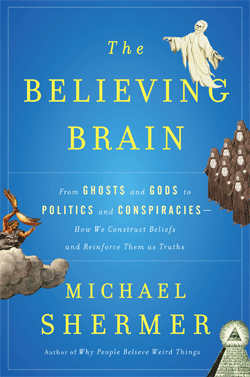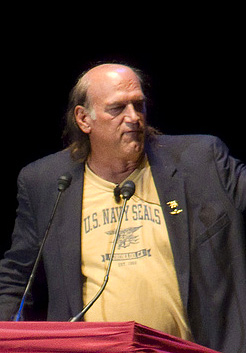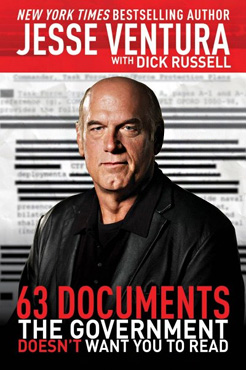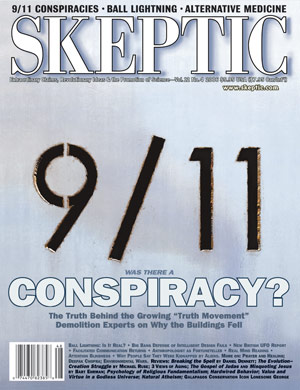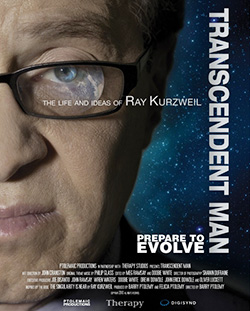On Monday afternoon, April 11, I appeared on Southern California Public Radio KPCC’s Patt Morrison show to briefly debate (dare I saw wrestle?) the former Navy Seal, Minnesota Governor, professional wrestler, television host, and author Jesse “The Body” Ventura, who was on a book tour swing through Los Angeles promoting his latest conspiracy fictions he believes are facts entitled The 63 Documents the Government Doesn’t Want You To Read. (The figure of 63 was chosen, Jesse says, because that was the year JFK was assassinated.) Presented in breathtaking revelatory tones that within lies the equivalent of the Pentagon Papers, what the reader actually finds between the covers are documents obtained through standard Freedom of Information Act requests that can also be easily downloaded from the Internet.
No matter, with bigger-than-life Jesse Ventura at the conspiratorial helm everything is larger than it seems, especially when his unmistakable booming voice pronounces them as truths. I had only a few hours to read the book, but that turned out to be more than adequate since most of the documents are familiar to us conspiracy watchers and what little added commentary is provided to introduce them appears to be mostly written by Ventura’s co-author Dick Russell, the pen behind the mouth for many of Jesse’s books. (Since he is no longer wrestling perhaps he should change his moniker to Jesse “The Mouth” Ventura.)
Surprisingly, given his background in the military and government, Ventura seems surprised to learn that governments lie to their citizens. Shockingly true, yes, but just because politicians and their appointed cabinet assigns and their staffers sometimes lie (mostly in the interest of national security but occasionally to cover up their own incompetence and moral misdeeds), doesn’t mean that every pronouncement made in the name of a government action is a lie. After all, as in the old logical chestnut—“This statement is untrue” (if it’s true it’s untrue and vice versa)—if everything is a lie then nothing is a lie. Likewise, I noted up front on the show, if everything is a conspiracy then nothing is a conspiracy.
Given the helter skelter nature of talk radio and Jesse’s propensity to interrupt through his booming voice any dissenters from his POV, I tried to make just four points. Let’s call them Conspiracy Skeptical Principles.
Conspiracy Skeptical Principle #1: There must be some means of discriminating between true and false conspiracy theories. Lincoln was assassinated by a conspiracy; JFK was not. The Archduke Franz Ferdinand was assassinated by a conspiracy of Serbian operatives that triggered the outbreak of the First World War; Princess Diana was not murdered by the Royal Family or any other secretive organization, but instead died by the most common form of death on a highway: speeding, drunk driving, and no seat belt.
Conspiracy Skeptical Principle #2: Cognitive Dissonance and the need to balance the size of the event with the size of the cause. Jesse Ventura said: “Do you mean to tell me that 19 guys with box cutters taking orders from a guy in a cave in Afghanistan brought down the most powerful nation on earth?” First of all, America is alive and well, thank you, even though Ventura has since moved to Mexico. But, yes, as a matter of fact, that is the only way such an event can happen: Sizable cohorts of operatives in prominent positions (Bush, Rumsfeld, Chaney, the CIA, the FBI, et al.) are too noticeable to get away with such a conspiracy. (By the way, 9/11 was a conspiracy: 19 members of Al Qaeda plotting to fly planes into buildings without telling us ahead of time constitutes a conspiracy.) It is the lone nuts living in the nooks and crannies of a free society (think Lee Harvey Oswald, John Hinkley, etc.) who become invisible by blending into the background scenery.
Conspiracy Skeptical Principle #3: What else would have to be true if your conspiracy theory is true? Jesse proclaimed on the show that the Pentagon was hit by a missile. His proof? He interviewed a woman on his conspiracy TV show who said she worked inside the Pentagon and never saw a plane hit it. Well, first of all, earlier in the show when I brought up Jesse’s conspiracy television series he discounted it, saying “that’s pure entertainment.” But now he wants to use an interview from that same show not as entertainment but as proof. As well, hardly anyone working in the Pentagon that day saw anything happen because they were inside the five-sided building and the plane only hit on one side, and even there, presumably (hopefully), people are actually working and not just sitting there staring out the window all day. But to the skeptical principle: As I said on the show, “If a missile hit the Pentagon, Jesse, that means that a plane did not hit it. What happened to the American Airlines plane?” Jesse’s answer: “I don’t know.” Sorry Jesse, not good enough. It’s not enough to poke holes at the government explanation for 9/11 (a form of negative evidence); you must also present positive evidence for your theory. In this case, tell us what happened to the plane that didn’t hit the Pentagon because there are a lot of grieving families who would like to know what happened to their loved ones (as would several radar operators who tracked the plane from hijacking to suddenly disappearing off the screen in the same place as the Pentagon is located). Finally, I directed Jesse and our listeners to www.skeptic.com to view the photograph of the American Airlines plane debris on the lawn in front of the Pentagon, below. Are we to believe that the U.S. government timed the impact of a missile on the Pentagon with the hijackers who flew the plane into the Pentagon?
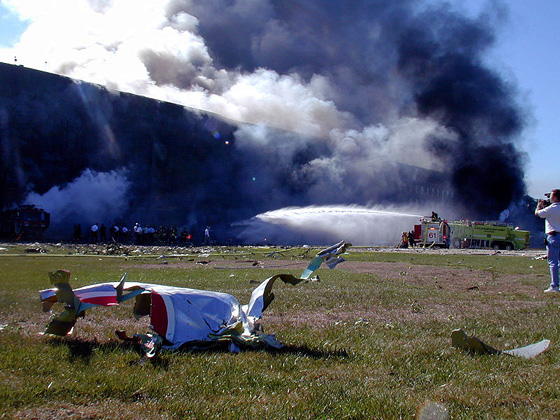
010911-N-6157F-001 Arlington, Va. (Sep. 11, 2001) — Wreckage from the hijacked American Airlines FLT 77 sits on the west lawn of the Pentagon minutes after terrorists crashed the aircraft into the southwest corner of the building. The Boeing 757 was bound for Los Angeles with 58 passengers and 6 crew. All aboard the aircraft were killed, along with 125 people in the Pentagon. (Photo by U.S. Navy Photo by Journalist 1st Class Mark D. Faram) (RELEASED)
Conspiracy Skeptical Principle #4: Your conspiracy theory must be more consistent than the accepted explanation. Jesse says that Osama bin Laden and Al Qaeda did not orchestrate 9/11, and instead it was done by the Bush administration (or, he says, at least by Chaney and his covert operatives). As evidence, Jesse wants to know why Osama bin Laden has not been indicted for murder by the United States government. As well, he says, why was no one fired for not acting on the famous memos of the summer of 2001 that warned our government that Al Qaeda was financing operatives in America in flight training schools and that Osama bin Laden would strike on U.S. soil. Hold on there Jesse—first you say that Osama bin Laden and Al Qaeda are innocent of this crime, and then you present evidence in the form of documents that the U.S. government was forewarned that Osama bin Laden and Al Qaeda would attack us? Sorry sir, you can’t have it both ways. You can’t hold to two contradictory conspiracy theories at the same time and use evidence from each to support the other. (Well, you can, but that would be a splendid example of logic-tight compartments in your head keeping separate contradictory ideas.)
Finally, in frustration I presume, Jesse accused me of being a mouthpiece of the government, just parroting whatever my overlords command me to say to keep the truth hidden. That conspiracy theory happens to be true, except for the part about the mouthpiece, the government, the parrot, and the truth.
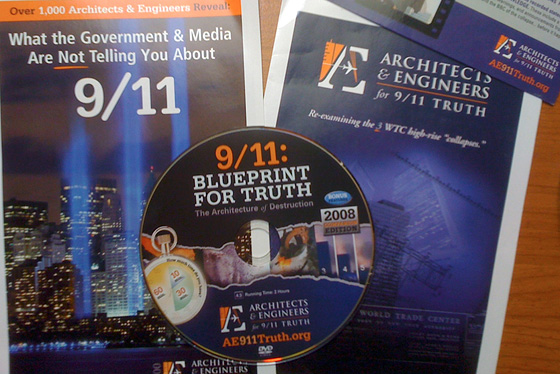
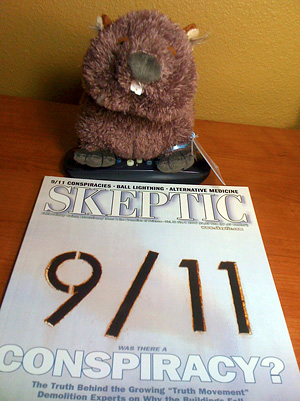
P.S. During my recent lecture tour swing through Wisconsin I was confronted at a restaurant by three 9/11 Truthers who were unable to attend my talk that night or even join the local skeptics group meeting that afternoon with me, and instead handed me a pile of literature and a DVD to watch touting the merits of the group known as Architects and Engineers for 9/11 Truth, who appear to hold fast to the belief that the WTC buildings were intentionally demolished by explosive devices AND that the hijackers (whoever they really were) somehow managed to fly the planes into the WTC buildings at precisely where the demolition experts planted the explosive devices—at the exact correct floors, at the exact angle at which the wings were tilted, because that is where the collapse of both buildings began. Check it out yourself below, along with our issue of Skeptic on 9/11 conspiracy theories, which was being read in Wisconsin by the little Wombat given to me by my hosts at the University of Wisconsin.



